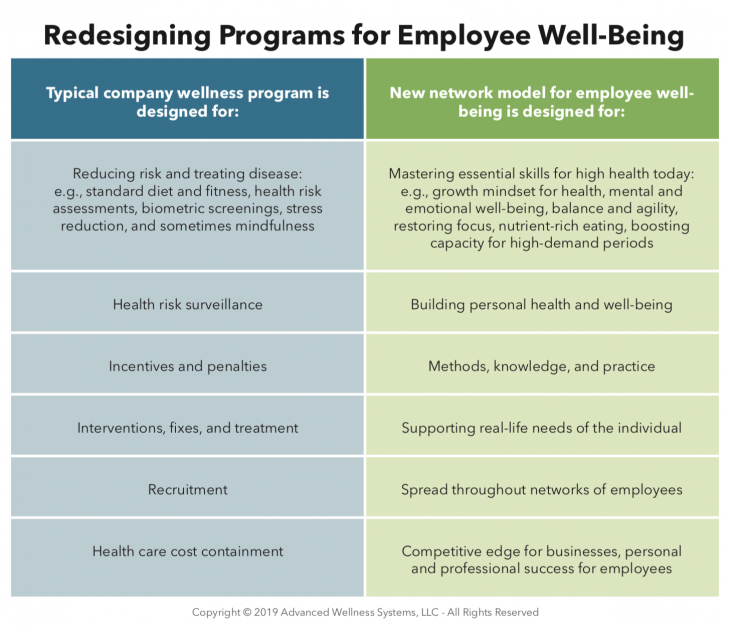You wouldn’t design a building with a 300-year-old blueprint, would you?
In essence, that’s what most of us do when we design or launch employee wellness programs. We are attempting to build healthy workplaces using a 300-year-old way of thinking about health and well-being—one that views the human body as a machine, a 17th century concept. This outdated notion reduces the body to parts and negatively skews the way we think about—and design for—health.

We must shift our thinking and modernize our conceptual blueprint.
Humans are not machines. We are complex, living systems with innate abilities to strengthen, restore, and renew our health and well-being.
High health and its power in the workplace
High health is a state of high capacity and overall well-being characterized by effective levels of personal energy, stamina, mental focus, and emotional composure alongside an absence of common illnesses. It reflects balance and optimal performance across multiple life dimensions.
High health and well-being arise when people adopt and sustain practices that optimize and integrate their physical, mental, emotional, purpose and life direction dimensions. They develop confidence in their abilities to re-balance and heal whether they work with health professionals in the process or not.
High health creates the dynamic balance, stability, and flexibility required to prosper, especially in our present milieu of constant change, disruptive economies, and escalating societal demands. It makes it possible for people to pursue what matters most to them (Young, 2018).
While we have gargantuan collections of data on the prevalence of diseases, we have very little data on the percentage of people with high states of health and well-being. One of the few researchers in this area found that about 20 percent of U.S. adults meet criteria for flourishing (Fredrickson, 2009).
Current wellness programs focus on pathology, not potential
Wellness programs are often launched in response to problems discovered through surveys, data analyses, and environmental evaluations. They are generally designed to “fix” these problems and threats of concern. Through reducing risks for diabetes, heart disease, cancer, and mental health conditions, wellness programs are expected to stave off disease and illness. Mitigating these risks and diseases will reduce health-related costs, improve productivity and ultimately longevity. As in so many other areas of life, there is feverish pursuit to develop technological methods that will supply a complete, final solution.
These types of fixes deliver modest and at times temporary improvements but not the expected increases in overall health and well-being, as analysis by Rand and others have revealed and as evidenced in the heated blog discussions about whether or not workplace wellness programs are beneficial (Mattke et al., 2013). Workplace well-being programs have been in effect for at least four decades and, while tools have changed, the methods and objectives have not (Goetzel, 2014).
These problem-oriented activities don’t promote true employee well-being. We need to pursue more relevant strategies for program design, and for that we need an entirely new blueprint.

A new design blueprint for employee well-being
Increasing employee health and well-being requires a design shift from fixing problems to building high levels of health, capacity, and well-being.
Humans are multidimensional living ecosystems. Our health and well-being are dependent upon interconnected processes occurring across all dimensions of life. These processes have patterns but are not predictable and cannot be reduced to individual parts (Capra & Luisi, 2014). Enhancing overall health requires a systematic approach that optimizes all of life’s dimensions, including the physical and non-physical. Such a blueprint provides a clearer understanding about health and the human body while building confidence, skills, and self-reliance.
With a little knowledge and consistent practice, employees can make an immense impact on their personal health and well-being. They experience an authentic way of relating to their health and often for the first time realize the power they have to shape and control all aspects of their physical and non-physical performance.
Redesigning employee wellness: essential practices for high health
Employee wellness programs need to modernize by pursuing health and capacity building as objectives. Then they must deliver knowledge and skills-based practices that, when mastered, produce and sustain high health and well-being among individuals and populations.
Essential practices include:
- a growth mindset for health;
- skills that connect people with meaning, purpose, and life direction;
- techniques for achieving mental well-being and emotional composure;
- plus upgraded methods for: nutrient-rich eating, efficient cardio conditioning, and balance and agility in physical movement.
These practices go beyond baseline fitness, diet, stress management, and screenings to form a foundation that upholds health as a “resource for everyday life… a positive concept emphasizing social and personal resources as well as physical capacities” (World Health Organization, 1986).

Using network effects to spread high health
In just about every survey I’ve conducted of employee wellness trends, we find that roughly 10 to 12 percent of the employee population is actively engaged in practices that support personal health and well-being, regardless of whether the company has a wellness program.
These are the employees who consistently use company or community fitness centers. They pay attention to food choices and are mindful about weight management. They often have less lost time from work and greater work production. Their regular attendance and participation in company-sponsored wellness events—including volunteering and serving on wellness committees—links them to one another. This is the basis of the informal well-being network that goes unrecognized in most organizations.
What if instead of overlooking these existing networks of well-being, we cultivated their growth and encouraged their spread? If you find this informal network that already exists and give it effective tools and attractive ideas, it will grow.
Network effects are known to be present in all settings; they proliferate in the business world. New science reveals that everything, from the global economy to the tiniest cell, is made of networks (Barabási, 2002). Networks follow predictable mathematical formulas and share fundamental properties—like the ability to spread ideas and behaviors fast. In groups, high-health practices spread, positively affecting the health and well-being of others. Researchers have validated this ripple effect in numerous studies. Such positive feedback loops benefit everyone.
The fastest, easiest, and most affordable way to move employee well-being forward in companies is to support networks of employees who are working on these essential skills.
Passive dependence vs. health empowerment
Because we often feel personally inadequate to take control of our health, we take a passive role in building and sustaining it and depend on external treatment services to manage it. Both sides expect more results than these services can deliver. Typical treatment approaches foster inadequacy, fear, dependence on authorities, and obedience. Patient deviation is met with shame, threat, and withdrawal of support.
Likewise, our employee wellness programs are typically designed to solve health-related problems among employee populations. As we have seen, these efforts have not delivered the outcomes of high capacity that we have hoped for.
We need to adopt a new understanding of health—one that focuses on maximizing our potential to experience higher levels of well-being.
Employees need knowledge, confidence, skills, self-reliance, and encouragement for experimentation that facilitates self discovery and personal insights.
Wellness programs must provide:
- communities of support;
- effective, science-based practices for increasing health;
- meaningful road maps;
- baseline and ongoing evaluations to assess progress;
- and periodic upgrades to make new knowledge and methods readily available.

Design for work and life today
Life is movement. There is no stasis. You’re either progressing—or regressing.
Which way is your employee wellness program headed? What about your own health and well-being practices?
Navigating work and life requires energy, stamina, mental focus, and emotional composure. If your employee well-being program is not enhancing these attributes, then your employees are regressing. Diet and fitness alone no longer cut it.
Companies want to help employees achieve high health and well-being. Doing so is possible, but it requires a design shift from fixing problems to building high levels of health, capacity, and well-being.
The more your programs advance, the more benefits employees will receive. High health leads to personal and professional success for individuals and a competitive edge for businesses. In the end, everyone comes out ahead.
References
Barabási, A.-L. (2002). Linked: The New Science of Networks. Cambridge, MA: Perseus Publishing.
Capra, F., & Luisi, P. L. (2014). The Systems View of Life: A Unifying Vision. Cambridge, U.K.: Cambridge University Press.
Fredrickson, B. L. (2009). Positivity. New York, NY: Crown Publishers.
Goetzel, R. Z. et al. (2014). Do Workplace Health Promotion (Wellness) Programs Work? Journal of Occupational and Environmental Medicine, Volume 56, Number 9, September 2014, 927-934.
Mattke, S., Liu, H. H., Caloyeras, J. P., Huang, C. Y., Van Busum, K. R., Khodyakov, D. and Shier, V. (2013). Workplace Wellness Programs Study: Final Report. Santa Monica, CA: RAND Corporation, RR-254-DOL, 2013. Retrieved from: https://www.rand.org/pubs/research_reports/RR254.html.
World Health Organization (1986). The Ottawa Charter for Health Promotion. Retrieved from: http://www.who.int/healthpromotion/conferences/previous/ottawa/en/index1.html.
Young, J. M. (2018). A New Way of Seeing: Health Is a Resource, Not a Problem. Retrieved from: http://highhealthnetwork.com/a-new-way-of-seeing-health-is-a-resource-not-a-problem-full.



